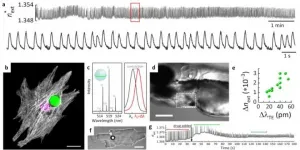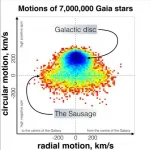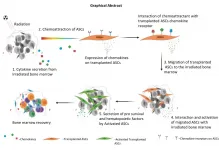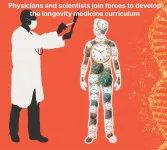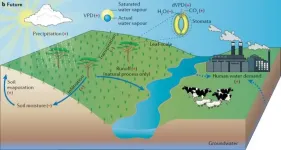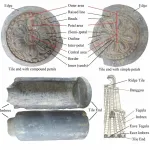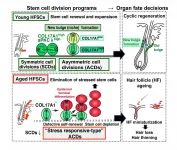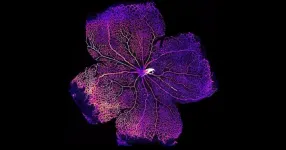INFORMATION:
Biosensing with whispering-gallery mode lasers
2021-03-16
(Press-News.org) Label-free optical sensors based on optical whispering-gallery-mode (WGM) microresonators exhibit extraordinary sensitivity for detecting physical, chemical, and biological entities, even down to single molecules. This extreme advancement in label-free optical detection is made possible by application of the optical microresonator, i.e. a 100 um glass microspheres, as optical cavity to enhance the detection signal. Akin to a spherical micromirror, the WGM cavity reflects the light by near-total internal reflection and thereby creates multiple cavity passes that enhance the optical detection of analyte molecules interacting with the evanescent field.
In contrast to the 'cold' WGM microresonators, the emerging active WGM microlasers have the potential to significantly expand the number of possible applications of this class of sensors in biological and chemical sensing, and especially in in vivo sensing. The WGM microlasers can sense from within tissue, organisms and single cells, and they can be used to improve upon the already impressive single-molecule detection limits of the 'cold'-cavity optoplasmonic WGM sensors.
Here, we review the most recent advances of WGM microlasers in biosensing. In contrast to the 'cold' cavity WGM sensors, the active WGM microresonators make use of gain media such as dye molecules and quantum dots to compensate for optical loss and to achieve lasing of the WGM modes. Similar to other conventional lasers, lasing is observed from narrow spectral lines in the WGM emission spectra.
We review the main building blocks of WGM microlasers, recently demonstrated sensing mechanisms, the methods for integrating gain media in WGM sensors, and the prospects for active WGM sensors to become a useful technology in real-world applications. We review WGM microlaser sensing experiments at the molecular-level where lasing spectra are analyzed to study the binding of molecules, to sensing at the cellular level where microlasers are embedded into or integrated with single cells to enable novel in vivo sensing and single-cell tracking applications (see figure).
ELSE PRESS RELEASES FROM THIS DATE:
LAMOST reveals new footprints of the Gaia -sausage-enceladus merger event
2021-03-16
Note: The dwarf galaxy corresponding to the Gaia-Sausage structure of the Milky Way was named Enceladus by astronomers, after one of the hundred-handed giants in Greek mythology who opposed the rule of Zeus.
Looking up at the starry sky, the deep Universe appears quiet and mysterious. It is hard to imagine that the ancient dwarf galaxy Enceladus violently collided and was torn apart by our own Milky Way Galaxy, leaving behind the cries of a whole new generation of children from the hundred-handed giant. Recently, SCIENCE CHINA: Physics, Mechanics & Astronomy published an (Editor's Focus) article titled "Low-α Metal-rich stars with sausage kinematics in the LAMOST survey: Are they ...
Propylparaben exposure during pregnancy may reduce protection against breast cancer
2021-03-16
WASHINGTON--Low doses of propylparaben--an estrogen-like chemical used as a preservative in personal care products and foods--can alter pregnancy-related changes in the breast in ways that may reduce the normal protection against breast cancer that pregnancy hormones convey, according to a new study being published in the Endocrine Society's journal Endocrinology.
These results, from an animal study that also will be presented at ENDO 2021, the Endocrine Society's annual meeting, lend evidence that propylparaben is an endocrine-disrupting chemical, the researchers say.
An endocrine-disrupting chemical interferes with the actions of hormones in the body. These chemicals can affect ...
Stem cells derived from fat show promise as a treatment for mass radiation exposure
2021-03-16
Durham, NC - Nuclear power offers an efficient, reliable way to provide energy to large populations - as long as all goes well. Accidents involving nuclear reactors such as those that took place in 1986 at Chernobyl and at Fukushima Daiichi after the March 2011 tsunami raise major concerns about what happens if the worst occurs and large numbers of people are simultaneously exposed to high levels of radiation. Currently, there are no effective, safe therapies for total body irradiation (TBI) - a condition known as acute radiation syndrome (ARS). That could change, ...
Physicians and scientists join forces to develop the longevity medicine curriculum
2021-03-16
16th of March, Tuesday, 2021 -- Longevity medicine is a rapidly evolving branch of preventative precision medicine that is specifically focused on promoting healthspan and lifespan, utilizing aging biomarkers commonly referred to as aging clocks. Over the past decade advances in AI and machine learning enabled the development of deep aging clocks (DACs) and other novel tools to track the rate of aging. In parallel novel preventative and therapeutic interventions have been discovered or progressed into clinical trials. Many medical and public health professionals do not have time to read the thousands of research papers covering this new field and actively engage in cutting-edge innovation ...
Toward a more comprehensive understanding of aridity changes over global drylands
2021-03-16
Global drylands are experiencing faster-than-average warming and are also among the most vulnerable regions to climate change. Meteorological metrics all point to an emerging trend of increased surface aridity, raising concerns of land desertification and degradation. However, recent satellite observations also show lusher drylands, in apparent contradiction to the image of drylands becoming drier. In a new Review Article published in Nature Reviews Earth & Environment, an international team comprehensively examined global dryland aridity changes with evidence from the literature and various sources of Earth observations and numerical ...
Study shows how varying climate conditions impact vulnerable species
2021-03-16
New findings on the diet of Arctic foxes, determined by the condition of their teeth, show how varying climate conditions in the Arctic affect the animals that live there.
In a study published in Polar Biology, Peter Ungar, Distinguished Professor of anthropology at the University of Arkansas, and several co-authors analyzed tooth breakage and wear - both gross and micro - of Arctic foxes from Russia's Yamal Peninsula.
Studying the effect of varying climate conditions within this region helps scientists understand the impact of climate change on ...
Commercial truck electrification is within reach
2021-03-16
When it comes to electric vehicles, particularly for heavy-duty trucks, the limitations of battery technology are often seen as the main barrier to widespread adoption. However, a new analysis concludes that it's the lack of appropriate policies around adoption incentives, charging infrastructure, and electricity pricing that prevents widespread electrification of commercial trucking fleets.
Researchers from the Department of Energy's Lawrence Berkeley National Laboratory (Berkeley Lab) and the University of California, Los Angeles published a new study that makes the case for prioritizing public policy to help move long-haul trucking from diesel to electric. Doing so will mean huge gains in addressing the ...
Roof-tiles in imperial China: Creating Ximing Temple's lotus-pattern tile ends
2021-03-16
Kanazawa, Japan -- Any visitor to China will have noticed the spectacular roofs on buildings dating from imperial times. However, the question of how these roof tiles were produced has attracted relatively little attention from archaeologists. Now, a team of researchers has conducted a major study of tile ends unearthed at the Ximing Temple in Xi'an, yielding exciting insights into their production.
In a study published in Archaeological Research in Asia, researchers from Kanazawa University and the Chinese Academy of Social Sciences have revealed the significance of minute variations in the tile ends used in the roof of the famous Ximing Temple in Xi'an, built during the ...
The bald truth - altered cell divisions cause hair thinning
2021-03-16
Researchers from Tokyo Medical and Dental University (TMDU) identify a novel mechanism underlying hair thinning and loss during aging
Tokyo, Japan - Hair grows from stem cells residing in hair follicles. During aging, the capability of hair follicles to grow hair is successively lost, leading to hair thinning and ultimately hair loss. In a new study, researchers from Tokyo Medical and Dental University (TMDU) and the University of Tokyo identified a novel mechanism by which hair follicles lose their regenerative capabilities.
Hair follicles are mini-organs from which new hair constantly grows. The basis for new hair growth is the proper function of hair follicle stem cells (HFSCs). HFSCs undergo cyclic symmetric and asymmetric cell divisions ...
Genetic discovery gives insight into causes of eye disease
2021-03-16
A genetic defect could hold the key to preventing or delaying the onset of a debilitating eye disease that can lead to vision loss and blindness.
MacTel (macular telangiectasia type 2) affects one in 1,000 Australians. Symptoms include slow loss of vision, distorted vision and trouble reading. Because early signs of the disorder are subtle, it is difficult to diagnose.
Researchers have identified an additional seven regions in the human genome that increase the risk of developing the condition, including a rare DNA mutation in the PHGDH gene, which will help clinicians to better diagnose and treat ...
